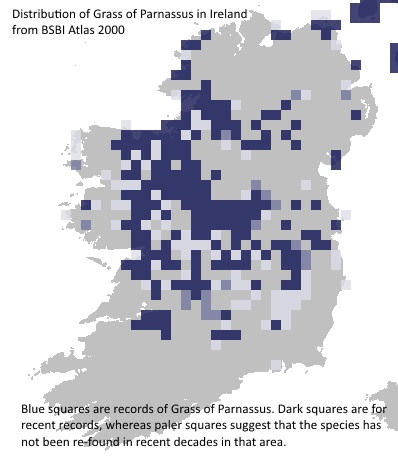Status
Native status
Native
Species Biology
Identification
- Small plants grow to a maximum of 30 cm, and flower from July to October.
- Their small cordate (heart-shaped, pointed at tip) leaves are basal and have long petioles.
- Each flowering stem has one heart shaped leaf, the round lobes of which wrap around the stem, and one flower.
- The 2cm wide flowers have five small green sepals, and five white petals with clear veins.
- The petals are slightly notched at their tips.
- The stamens of the flower are a good identifying feature. There are 5 stamens and in between each is a fan shaped sterile stamen. The branches of these fans end in a yellow/green glands.
- The four-lobed stigma emerges from the top of the fused carpels
which form a large superior pink-tinged ovary.
There are no other closely related species
in Ireland.
Grass of Parnassus is not easily confused
with other species in damp grassland. Its key identifying feature is the
non-fertile fan shaped stigmas. Check the basal heart-shaped leaves and single
sessile stem leaf to separate Grass of Parnassus from other white flowers.
Habitat
Grass of Parnassus grows in damp grassland
and habitats such as dune-slacks, fens, lake shores and mountain cliffs.
In parts of the west and midlands of
Ireland Grass of Parnassus is locally common, but it is much less so in other
parts of the country, with apparent losses in the south midlands.
Threats faced
Habitats are under threat of being lost due to land abandonment, agricultural improvement and drainage.
Distribution
World distribution(GBIF)
BSBI distribution map

Temporal change
Records submitted to Data Centre in 2025
The following map is interactive. If you would prefer to view it full screen then click here.
How can you help
If you have seen Grass of Parnassus or any
of the species in the Irish Species Project, please fill out a recording form.
It can be downloaded here, and you
can also download the guidance document
for detailed instructions (both also available at http://www.bsbi.org.uk/ireland.html).
You can also get in touch with your local
BSBI Vice County Recorder via Maria Long, BSBI Irish Officer (maria.long@bsbi.org) or contact her if you have any questions.
Further information
One of eight species chosen for the Irish Species Project, a two year recording effort by the Irish division of the Botanical Society of Britain and Ireland (BSBI). All eight species are thought to be declining, at least in parts of their range.
Full list of eight species included in the Irish Species Project:
Moonwort (Botrychium lunaria), Cyperus Sedge (Carex pseudocyperus), Autumn Gentian (Gentianella amarella), Toothwort (Lathraea squamaria), Grass-of-Parnassus (Parnassia palustris), Cowslip (Primula veris), Common Wintergreen (Pyrola minor), Cranberry (Vaccinium oxycoccos)
References
Publications
Parnell J. and Curtis T. (2012) Webb’s An Irish Flora. Cork: Cork
University Press 8th ed.
Preston C.D., Pearman D.A. and Dines T.D.
(2002) New Atlas of the British and Irish
Flora: An Atlas of the Vascular Plants of Britain, Ireland, the Isle of Man and
the Channel Islands. Oxford: Oxford University Press
Rose F. and O’Reilly C. (2006) The Wild Flower Key: how to identify wild
flowers, trees and shrubs in Britain and Ireland. London: Frederick Warne rev.
ed.
Stace C. (2010) New Flora of the British Isles. Cambridge; New York: Cambridge
University Press 2010 3rd ed.
